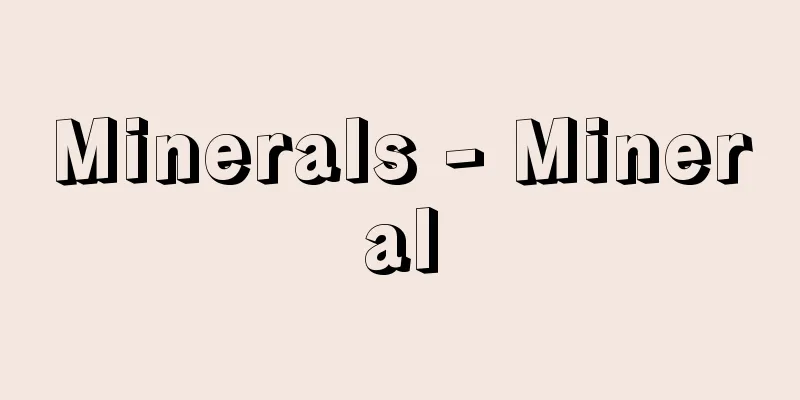Minerals - Mineral

|
A substance that occurs naturally and is homogeneous, with a nearly constant chemical composition and atomic arrangement, and is currently inanimate. With a few exceptions (natural mercury and water), it is solid at room temperature. [Akira Kato, August 19, 2016] Number of typesAs of December 2013, there are approximately 5,000 known species worldwide, of which approximately 1,300 are known in Japan, with an average annual increase of 60 to 80 species. [Akira Kato, August 19, 2016] TaxonomyIt is possible to classify each class into two types: non-systematic, which allows overlapping arrangements, and systematic, which does not allow overlapping arrangements. The former includes, for example, genetic classification and applied classification, while the latter includes, for example, crystallographic classification and chemical classification. [Akira Kato, August 19, 2016] Current classificationThe classification that is currently widely used is a combination of chemical classification and crystallographic classification, which corresponds to the emphasis on chemical composition and atomic arrangement in the definition of mineral species. The first to propose it was Berzelius of Sweden, and after many refinements, the classification by Hugo Strunz (1910-2006) of Germany and Ernest Henry Nickel (1925-2009) of Australia is currently the most widely used. Here, we introduce the classification by the author, which is a further refinement of the previous classification. Minerals are first classified into inorganic minerals and organic minerals. [1] Inorganic minerals Inorganic minerals are broadly divided into three types: (1) A mineral that is essentially made up of a single element (1) Elemental minerals The cations that characterize these acid groups are all surrounded by three or four oxygen atoms (up to six in the case of some hydroxylated fluorine atoms), i.e., oxygen coordination numbers are three or four. Thus, heteropolyacid salts such as the phosphomolybdates are classified as phosphates, since the coordination numbers of phosphorus (P) and molybdenum (Mo) are all known to be four and six, respectively. Chemically, the multivanadates are classified as oxides, since most of the vanadium (V) in them has a coordination number of five or six. As a compound, the ferrous metaniobate ferrocolumbite is classified as an oxide because its coordination number for niobium (Nb) is six, not four. Assigning minerals to systematic classification units can be problematic when they contain oxygen. However, oxygen has a strong tendency to form atomic groups with some regularity (such as the possession of symmetrical elements) around specific cations. Therefore, if a systematic classification system is constructed based on the type of cation that is the center of the atomic group, it can be made to have the same weighting for all minerals that contain oxygen. In such cases, the criterion for determining whether an atomic group has been formed is the number of oxygen ions around the cation in question; if there are four, the existence of an atomic group is recognized morphologically. However, if there are six, the behavior of an atomic group, such as forming a hidden ion as an acid group, does not exist, with a few exceptions. The exception is Te 6+ (hexavalent tellurium ion), which clearly forms the atomic group [TeO 6 ] 6- . Nb 5+ (pentavalent niobium ion) and Ta 5+ (pentavalent tantalum ion) are six-coordinated in oxides and do not form acid groups morphologically, so they are treated as oxides. The pentacoordinated atomic group is almost unique in that it has a V5 + (pentavalent vanadium ion) located at the center of a square pyramid with two V5+ ions bonded to one edge of the base, forming [ V2O8 ] 6- . There is a group of vanadates characterized by the presence of an acid group with this shape, so it was once classified as a vanadate, but in the Strunz and Nickel classification (2001), a special category called vanadium compounds has been established among oxides, and it is classified in this category. [2] Organic minerals Because there are only a small number of organic minerals (about 50 species), there are no major classifications that correspond to the inorganic minerals described below. Organic minerals include organic acid salt minerals, hydrocarbon minerals, and carbohydrate minerals. [Akira Kato, August 19, 2016] Mineral NameMineral names are either existing or newly discovered. The original author must obtain approval from the International Mineralogical Association (IMA) Committee on New Minerals, Nomenclature and Classification before publishing the paper. In principle, the mineral name is the name of the place of origin, the name of a person, or the English pronunciation of a chemical symbol, followed by the suffix -ite, but of course the same name cannot be used and there are some restrictions. When multiple minerals with similar chemical compositions form a series, especially for species that are mainly composed of rare earth elements, the English names are distinguished by the suffix of the element symbol of the most abundant element in parentheses, such as xenotime-(Y) and xenotime-(Yb). This rule is also used for pumpellyite, which is represented as pumpellyite-(Al). When the composition is complex, multiple element symbols are listed, such as jahnsite-(CaMnMg). On the other hand, when it becomes necessary to distinguish between polytypes (phases in which the units are stacked in different ways when the material is divided into layered structural units), suffixes such as graphite-2H and graphite-3R for graphite have been used. The first number indicates how many times the unit cell is larger than the basic atomic arrangement unit, and the following letters are abbreviations for the crystal system, indicating a hexagonal or rhombohedral crystal system, respectively. Since then, many species have been discovered with multiple lattices in each direction of the crystal axis, and the previous method of expression has become insufficient, so the extended symbols polybasite- M 2 a 2 b 2 c have been used. Until now, no problems have arisen in the phases to which this applies, since the repeating units have been identical in composition, but in 2002, it was discovered that ferrohögbomite (Fe 2+ 3 ZnMgAlAl 14 Fe 3+ TiO 30 (OH) 2 ) is composed of an accumulation of two different structural units, and it became necessary to specify the contents of these structural units in order to identify the species. To address this, the name ferrohögbomite-2 N 2 S , which includes the structural unit suffix -2 N 2 S, has been approved as the official name. In this formula, N is the structural unit of nolanite, whose prototype is the atomic arrangement of (V, Fe, Ti) 10O14 (OH) 2 , and S is the structural unit of spinel, whose prototype is that of MgAl2O4 . [Akira Kato, August 19, 2016] Physical properties(1) Color The color of a mineral is the color of the absorbed transmitted light in transparent minerals, and the color of the reflected light in opaque minerals. In other words, the color is a mixture of light of various wavelengths that is not absorbed in the white light that hits the material and is reflected. Even if a mineral is colorless and transparent, if it becomes an aggregate of polycrystals, reflection occurs at the interfaces between the grains and the color becomes whitish, so the color varies somewhat depending on the state of the mineral itself. In minerals that contain heavy metals that produce colored cations, the color is often reflected in the color of the mineral itself. (2) Luster Depending on the appearance of each luster, it is described using terms such as no luster (roughly corresponding to earthy luster), vitreous luster, pearlescent luster, silky luster, resinous luster, greasy luster, sub-adamantoid luster, adamantoid luster, submetallic luster, and metallic luster. (3) Streak: The color is observed after rubbing the mineral on a white porcelain plate called a streak plate. For minerals harder than the streak plate, the powder is crushed using a different method and observed. However, the streaks of such hard minerals are colorless or white. Since the location of streaks can be confirmed by their color, color is an essential characteristic of the mineral, and the expression "streak color" is not appropriate. It is not called streak color in English either. Mineral streaks are generally a lighter color; for example, iron ore appears black, while the streaks are closer to white. Wakabayashiite appears yellow, but the streaks have an orange tinge that does not show up on the surface at all. (4) Hardness When measuring the hardness of minerals, Mohs hardness is often used, which determines the relative abrasion hardness between minerals using reference minerals, and Vickers hardness is a type of indentation hardness, which is obtained by pressing a weighted diamond needle (actually a square pyramid) into the surface of a flat, polished mineral and measuring the size of the mark, and there is a certain functional relationship between the two. The data notes on ores and minerals in this encyclopedia use Mohs hardness. (5) Cleavage A single crystal of a crystalline material has the property of breaking along one or more flat planes when mechanical force is applied. Such planes are called cleavage planes. The degree of cleavage is described in five stages: complete, clear, good, incomplete, and unclear, and its direction is determined in the same way as for crystal planes. The direction is described using the same method as Miller indices. Cleavage is closely related to the atomic arrangement of the mineral. In principle, cleavage in the same direction exists in the same type of mineral, but the degree of cleavage may vary slightly depending on the chemical composition of the solid solution. In zinc blende, the degree of cleavage tends to decrease as the amount of iron substituting for zinc increases. (6) Cleavage: In minerals that do not have cleavage, or in minerals that have cleavage, depending on the place of origin or the conditions of occurrence, a surface that appears to be cleavage-like may be seen to develop in a direction parallel to one another in a direction in which cleavage would not normally develop. This is called cleavage, and is described in the same way as cleavage. (7) Fracture: The opening of a mineral that has no cleavage or that is in a direction other than cleavage is called a fracture. To describe it, it is broadly classified as smooth or uneven, and the uneven cases are expressed by terms such as conch-shaped, serrated, etc. (8) Specific gravity It is similar to the concept of normal specific gravity, but in the case of minerals, the solid may contain inclusions or have voids, so it may be necessary to distinguish between apparent specific gravity and true specific gravity. It is usually expressed as the ratio of the weight of the mineral to the weight of the same volume of water at 3.98°C, and no unit is used. Density is also used in the same way as specific gravity, but it requires a unit, and is often given in grams per cubic centimeter (g/ cm3 ). (9) Others The above are the attributes that characterize many minerals and are always the subject of observation when describing them, but there are also other properties that can be important depending on the case. These include thermal properties (heat of formation, thermal conductivity, coefficient of thermal expansion, specific heat, heat of fusion, heat loss curve, differential thermal analysis curve, etc.), electrical properties (electrical conductivity, thermoelectricity, pyroelectricity, piezoelectricity, etc.), magnetic properties, and viscoelasticity (brittleness, softness, malleability, ductility, toughness, flexibility, etc.). In addition, touch, odor (due to impact, heating, or blowing on the mineral), and taste are sometimes added to the physical properties. [Akira Kato, August 19, 2016] Optical propertiesThe properties that minerals give to visible light include refractive index, birefringence, optical orientation, optical axis angle, optical axis dispersion, optical symbol, presence or absence of pleochroism, and axial color for transparent minerals, and reflected color and reflectance for opaque minerals. Among these, those that can be quantitatively expressed are important for identification. [Akira Kato, August 19, 2016] Chemical propertiesMinerals are chemical substances, and their chemical composition is directly related to their definition, so among their chemical properties, empirical formulas, ideal chemical formulas, chemical components, etc. are essential for description. In addition, simple chemical reactions can be important for identification. (1) Empirical formula Ideally, a complete chemical analysis is used to determine the components of a mineral and their content, and those that can be grouped together from a crystal chemistry perspective are grouped together and the ratio of each component is calculated. Depending on the analytical method, when elements with small atomic weights such as hydrogen, lithium, and beryllium cannot be analyzed qualitatively or quantitatively, their presence may be confirmed qualitatively, and their content may be estimated and converted into chemical analysis values. In the case of a single element with different valences such as iron, if the valence state cannot be determined, their ratios may be estimated or predicted and calculated. In principle, an empirical formula may be created by establishing integer ratios between groups of compositions with similar properties obtained as a result of such operations. Strictly speaking, this part is not supported by experiments, but the term empirical formula is permitted as a description. (2) Ideal chemical formula: This is a chemical formula in which minor components are excluded from the empirical formula, and only those components that are deemed to be essential are used, with the ideal ratio being used. Whether this formula is actually applicable must depend on the determination of the crystal structure, but it has value as a working hypothesis even before the structure is described. However, some are of the opinion that it is inappropriate to apply this type of mineral to minerals such as pentlandite (chemical formula (Fe,Ni) 9 S 8 ), in which both Fe and Ni are essential components in a non-stoichiometric ratio with a certain range, and therefore the adjective "ideal" cannot be used for something that does not indicate the ratio of the two. (3) Structural formula: A formula derived from the ideal chemical formula or empirical formula by determining the crystal structure, which serves as basic reference information for the crystallographic classification of minerals. In addition, the coordination number of atoms in the formula may lead to the estimation of the formation conditions. (4) Properties of Reagents Reagents are acids such as hydrochloric acid, sulfuric acid, and nitric acid, alkalis, and water, and are often used to observe the reaction of minerals with these. For example, many carbonates are decomposed by acid and release carbon dioxide, and some sulfides react with acid and emit the foul odor of hydrogen sulfide. These results are useful for identification. [Akira Kato, August 19, 2016] Crystallographic propertiesThe properties of minerals related to crystallography include: (1) Morphology The exterior of a mineral may be surrounded by planes determined by certain laws governed by the crystal system. These planes are called crystal faces, and a collection of them is called the crystal morphology or crystal shape. The crystal faces reflect the regular atomic arrangement inside the mineral. The morphology of a mineral is governed in principle by the way in which the crystal faces develop, and terms such as hair-like, needle-like, columnar, plate-like, pyramidal, leaf-like, and granular are used to describe them, with short or long terms added as necessary. When multiple crystals are aggregated, there are terms that show regularity (for example, parallel intergrowths and twins), terms that do not show regularity and are somewhat unspecific, such as radial, spherulitic, bunch-like, membrane-like, fibrous, dendritic, and cluster-like, and terms that liken them to objects, such as grape-like and kidney-like. (2) Atomic Arrangement The atomic arrangement of a crystalline substance is called a crystal structure, and most atomic arrangements of minerals fall into this category. The arrangement can be described as either a single atom or as a group of atoms with one atom at the center. If this group of atoms is considered as a polyhedron or polygon, the shape often has an element of symmetry, and for this reason the central atom often lies on an element of symmetry such as the center, plane, or axis of symmetry. (3) Crystal chemistry There are four types of chemical bonds between atoms: ionic, covalent, metallic, and van der Waals bonds. If atoms are considered as spheres, they can be treated as being in contact with neighboring atoms with a certain bond radius. Atoms with similar bond radii, small or identical valence differences, and similar chemical properties can replace each other while maintaining the atomic arrangement of the mineral as a whole, which is called isomorphous substitution. This is one of the causes of the complexity of the chemical composition of minerals. On the other hand, some minerals have different atomic arrangements even if the types and quantitative ratios of the constituent elements are the same, which is called polymorphism. Multiple mineral species that have this relationship, such as graphite and diamond, often show different formation conditions (in this case, different physical conditions). [Akira Kato, August 19, 2016] CauseAlthough the origins of some minerals are unknown, such as the water that makes up seawater, the components of meteorites, or components of cosmic dust, the following three are generally considered to be the origins of minerals: (1) When generated from a fluid such as a gas, liquid, or melt [Akira Kato, August 19, 2016] OccurrenceOccurrence is said to be an abbreviation of the state of occurrence, but because it includes minerals that are not actually produced at the site, this term was once rejected and the term "appearance state" was considered correct. Nowadays, "occurrence" is used more. Minerals are the smallest units that make up the earth's crust, and they always occur in groups, so occurrence is a description of the way they are assembled. Therefore, it is desirable for the description to express both the state of the mineral itself and the state of the group. For example, there are methods that focus on the geological unit, such as "As a rock-forming mineral, it constitutes a rock body made of this type of rock," and methods that take into account the formation process, such as whether it is a primary mineral or a secondary mineral, and by combining these, it can be made more concrete. In other words, if rock-forming minerals are subdivided into igneous minerals, sedimentary minerals, metamorphic minerals, metasomatized minerals, etc., their nature as components of groups that are the products of geological phenomena can be made clearer. Currently, it is thought that descriptions of mineral occurrences should be done as freely as possible, in a way that maximally emphasizes the significance of the existence of the mineral in question. [Akira Kato, August 19, 2016] Utilization of mineral resourcesMineral resources include minerals of useful metallic elements that are indispensable in our daily lives, as well as many other minerals that are used for a wide range of purposes, such as in the chemical industry, as raw materials for ceramics, as energy sources, etc. Research and development into the use of mineral resources has been conducted since ancient times, but in today's world where the global population is increasing, it is not only desirable to make effective use of these resources, but the development of unused mineral resources and the development of new ways of using them are also important issues that remain for the future. [Akira Kato, August 19, 2016] CollectionMineral collecting is the most basic activity involving minerals, and it is also the foundation for subsequent activities. Of course, the emphasis is different when collecting minerals as a scientific activity and when collecting minerals as a hobby, and so the preparation methods are naturally different, but here we will mainly discuss the latter. First, regarding the selection of a destination, there are two methods: one is to not set a specific destination and get an idea from literature and geological maps, and the other is to narrow down the destination based on information on the source area. The latter method does not require any special explanation, so we will explain the former. Even with this method, at a minimum, a general knowledge of geology is necessary. Geological units and combinations that are worth considering as targets include granite pegmatites (pegmatite minerals and rock-forming minerals), granite contact zones, especially contact areas with limestone and dolomite (contact metamorphic minerals, skarn minerals, metallic minerals), ultramafic rocks (serpentine minerals and vein minerals), regional metamorphic rocks (metamorphic minerals and vein minerals), metamorphosed layered manganese minerals (primary manganese ore minerals, secondary manganese ore minerals, metamorphosed minerals), volcanic rocks or pyroclastic rocks (zeolites and cavity minerals), etc. Next are the tools for collection. The first thing you need for collection is a rock hammer. Both large and small hammers are useful, but it is better to start with a small one (1.5 or 2 pounds) and get used to it. The hammer is of course a tool for breaking rocks by striking them, and you should strike with the upper edge of the square cross section, and swing it so that the area that hits is as small as possible. The way to swing it is to use your whole arm from the time you raise it to the middle, and your wrist at the end, and loosen your grip at the moment of impact. The next thing you need is a chisel, which can be round or flat. The former is effective for rocks with little directionality, while the latter is effective for rocks that have directionality and are not very hard. To observe the collected items more closely, you will need a magnifying glass. It is easier to use a magnifying glass with two lenses on both ends of a short tube than a one-lens telescope-style one. To record what you observe, prepare writing utensils and a field notebook. Sometimes a camera or video camera is also effective. For this type of work, a topographical map is essential to enable accurate location of the site, and even better a compass, altimeter and GPS device. For specimens collected in large numbers, numbers and symbols are written on them for identification. Felt-tip pens are used for this, but for specimens that may be used later for gas analysis, such as volcanic rocks, ultramafic rocks, and organic matter-containing sedimentary rocks, using felt-tip pens or newspaper can cause contamination, so they are placed in polyethylene bags, sealed, and the numbers written on the surface. For ordinary collections, newspaper, cotton bags, polyethylene bags, etc. are used, and specimens that are not likely to be damaged by contact with other specimens are kept together as much as possible. Fragile specimens are wrapped in tissue paper or absorbent cotton, and finally secured with cellophane tape, and the number is written on the wrapped material. The above is the usual case, but for specimens obtained by a process called panning, in which river sand is separated in running water using a container such as a bowl or tray to extract minerals with a high specific gravity, polyethylene bags to put them in, a sorting magnet, and tweezers are effective. [Akira Kato, August 19, 2016] Preservation and organization of specimensRather than preserving all the collected specimens, it is better to observe them thoroughly and preserve only the necessary ones. The selection criteria usually focus on the target mineral itself, such as large grain size, freshness, and well-developed external shape, or on minerals with well-known occurrences, clear coexistence relationships, clear formation order, or other factors. In addition, there are also cases where rare minerals or unidentified minerals are targeted. In any case, the purpose of preservation must be clear. In order to preserve specimens, they are shaped so that they are easy to organize, i.e., they are shaped by removing unnecessary parts, washed to make sure they are free of dirt, and then stored in a suitable small box or container, which is then kept in a chest of drawers, etc. A specimen is complete only when the actual specimen and its label are included. The label contains necessary information such as the mineral name and place of origin. If necessary, a common number is assigned to the specimen and label, and a ledger is created to organize them. There are many ways to organize specimens, such as by place of origin, classification, composition, and geographical location, and each method has its advantages and disadvantages. Whichever method is used, it is best to standardize on the method that is most convenient for use as a specimen. Another method is to not organize specimens at all, but to use cards or a computer to organize them. [Akira Kato, August 19, 2016] Observation of specimensIf you are observing a specimen you have actually collected in the field in more detail, you can provide a certain amount of geological information about the specimen containing the mineral in question, except in special cases (such as minerals in placers). Collection, specimen preparation, and observation are activities that aim to obtain information about the mineral in question itself and better geological information about the specimen that contains it. If the specimen contains multiple minerals, you can obtain information such as the context and differences in chemical composition that cannot be obtained from a specimen of a single mineral. The presence or absence of reference specimens and reference literature is also important, but the ability to analyze and make judgments is also one of the things that must be taken into consideration in order to make effective use of specimens. [Akira Kato, August 19, 2016] "A Journey of Mineral Collecting," by Akira Kato et al., 5 volumes (1972-1983, Tsukiji Shokan)" ▽ "Geochemistry of Rocks and Minerals," edited by Yoshito Matsui and Shohei Sakano (1992, Iwanami Shoten)" ▽ "New Edition of Earth Science Education Course 3: The Science of Minerals," edited by the Earth Sciences Research Association (1995, Tokai University Press)" ▽ "Picture Book of Rocks and Minerals -- Full Color 500 Rocks and Minerals of the World," by Chris Pelant and supervised by Ichiro Sunagawa (1997, Nihon Vogue-sha)" ▽ "Treasure Hunt of the Earth -- National Mineral Collecting Guide," revised edition, edited by the Japan Mineral Club (1998, Kaikoshi Publishing)" ▽ "Introduction to Earth's Mineral Resources," by Toshimichi Iiyama (1998, University of Tokyo Press)" ▽ "Fun Mineralogy -- From Basic Knowledge to Appraisal," new edition, by Hidemichi Hori (1999, Soshisha)" ▽ "Mineral Color Illustrated Guide to Mineral Resources" (1999, Natsumesha)" ▽ "Makino Kazutaka, Color Edition Encyclopedia of Mineral Resources" (1999, Nikkan Kogyo Shimbun)" ▽ "Wada Ishiro, "Japanese Breeding Specimens" and "Japanese Breeding Journal" (2001, University of Tokyo Press)" ▽ "Isobe Katsu, "National Natural History of Minerals that Enrich Your Life" (2002, Bungeisha)" ▽ "Kimata Mizen and Miyano Takashi, "New Edition of Searching for Primary Colors" (2003, Kitatakakan)" ▽ "Yakawa Shizue, "Everything About Minerals Understanding Elements" (2011, Chuo Art Publishing)" ▽ "Eric Shaleen, Translated by Uehara Yuko, "Illustrated: 50 Minerals That Changed World History" (2013, Hara Shobo)" ▽になったんです。 English: The first thing you can do is to find the best one to do. [Reference Items] | | | | | | | | | | | | | | | | | | | | | | | | | | Hardness | | |Source: Shogakukan Encyclopedia Nipponica About Encyclopedia Nipponica Information | Legend |
|
天然に産する物質で、ほぼ一定の化学組成と原子配列をもつ、現在生命力をもたない均質物質をさす。少数の例外(自然水銀および水)を除いて常温で固体である。 [加藤 昭 2016年8月19日] 種類の数2013年(平成25)12月時点で、世界全体で約5000種、うち日本国内で約1300種知られており、年平均60~80種増加している。 [加藤 昭 2016年8月19日] 分類法類別した各類に重複配置を許す非系統分類と、重複配置を許さない系統分類とが可能である。前者には、たとえば成因的分類、応用的分類などがあり、後者には結晶学的分類、化学的分類などがある。 [加藤 昭 2016年8月19日] 現行の分類現在広く用いられているものは、化学的分類と結晶学的分類の組合せであって、鉱物種の定義において化学組成と原子配列とが重視されていることに対応している。最初の提唱者はスウェーデンのベルツェリウスで、その後幾多の改良を経て、現在はドイツのシュツルンツHugo Strunz(1910―2006)およびオーストラリアのニッケルErnest Henry Nickel(1925―2009)によるものがもっとも広く用いられている。ここではこれをさらに改良した筆者の分類を紹介する。 鉱物はまず無機鉱物と有機鉱物に分類される。 〔1〕無機鉱物 (1)基本的に単一種の元素からなる鉱物 (1)元素鉱物 これらの類名となる酸基を特徴づける陽イオンは、すべて3個あるいは4個の酸素原子(一部のヒドロキシ基を含むフッ素原子の場合は6個まで)によって囲まれている。つまり対酸素配位数が3あるいは4ということである。したがって燐モリブデン酸塩鉱物のようなヘテロポリ酸塩鉱物の帰属は、現在知られているものではリン(P)の配位数は4、モリブデン(Mo)の配位数は6であるため、これはリン酸塩鉱物のなかに入れられている。化学的には酸基とされる多重バナジン酸塩の鉱物は、そのなかのバナジウム(V)の大部分の配位数が5あるいは6であるため、酸化物に含められる。化合物の名称としては、メタニオブ酸第一鉄塩である鉄コルンブ石の帰属が酸化物となっているのも、ニオブ(Nb)の配位数が4ではなくて6であることによる。 鉱物の系統分類単位への帰属が問題となる場合が発生するのは酸素が含まれている場合であるが、その酸素は特定の陽イオンの周囲に多少とも規則性(対称要素の保有など)をもった原子団をつくる傾向が強いので、その原子団の中心となる陽イオンの種類で系統分類体系を構築すると、酸素を含む鉱物全体に共通して同じウェイトで作用する内容のものにすることができる。 このような場合、原子団がつくられているかどうかの判定基準は、問題となる陽イオンの周りに何個の酸素イオンがあるか、その数字に求められ、4個であれば形態的に原子団の存在が認められる。しかし、6個になると原子団としての挙動、たとえば酸基として隠イオンをつくるようなことは、一部の例外を除いて存在しない。なお例外はTe6+(6価のテルルイオン)で、これは明らかに[TeO6]6-という原子団を構成する。Nb5+(5価のニオブイオン)やTa5+(5価のタンタルイオン)は酸化物中では6配位の形をとり、形態上は酸基を構成しないので酸化物として扱われる。 5配位の原子団は正方錐(すい)の中心にV5+(5価のバナジウムイオン)が位置し、これが底面の一辺をなす稜(りょう)で2個結合した[V2O8]6-がほとんど唯一のものであり、この形をもった酸基の存在で特徴づけられる一群のバナジン酸塩があるので、かつてはバナジン酸塩に含められたが、シュツルンツ分類Strunz and Nickel classification(2001)では酸化物のなかにバナジン化合物という特殊枠が設けられ、このなかに入れられている。 〔2〕有機鉱物 有機鉱物には有機酸塩鉱物、炭化水素鉱物、炭水化物鉱物がある。 [加藤 昭 2016年8月19日] 鉱物の名称鉱物名は従来から存在するものと、新鉱物として発見されて命名されたものとがある。原記載者は論文発表に先だって、国際鉱物学連合International Mineralogical Association(IMA)の新鉱物・命名・分類委員会の承認を受ける必要がある。原則的には、産地名や人名あるいは化学記号の英語読みなどの単語のあとに接尾語-iteをつけて鉱物名とするが、もちろん同一名称は使用できないし、多少の制限がある。なお、類似の化学組成をもつ複数の鉱物が系列を構成している場合、とくに希土類元素を主成分とする種については、その英名はゼノタイムのxenotime-(Y)、xenotime-(Yb)のように、そのなかでもっとも多量に存在する元素の元素記号を括弧(かっこ)でくくった接尾語を使って区別するという規定となっている。なおこの規定はパンペリー石などについても用いられ、pumpellyite-(Al)のように表される。また、成分が複雑な場合は、ジャーンザイトjahnsite-(CaMnMg)のように複数の元素記号が列記される。一方これとは別に、多型polytype(層状の構造単位に分割される場合、その単位の積み重なり方が異なる相)を区別する必要が生じた場合は、石墨のgraphite-2H、graphite-3Rというような接尾語を用いることで処理してきた。最初の数字は単位格子が基本的な原子配列単位の何倍になっているかを示し、あとの文字は結晶系の略号で、それぞれ六方晶系、菱面体(りょうめんたい)晶系を示す。 その後、結晶軸の各方向に倍数の格子をもつ相が数多くの種について発見され、これまでの表現方法では不十分になってきたので、ポリバス鉱polybasite-M2a2b2cというように拡張記号が使用されるようになった。これが適用される相では、これまで、繰り返される単位の構成内容が同一であったため問題は生じなかったが、2002年に発見されたferrohögbomite(Fe2+3ZnMgAlAl14Fe3+TiO30(OH)2)では、2種の異なった構造単位の集積からなることが明らかにされ、種の識別上それら構造単位の内容まで限定する必要が生じた。これに対応するため、-2N2Sという構造単位接尾語をつけたferrohögbomite-2N2Sという名称が正式名称として承認されている。なお、このなかの記号Nはノーラン鉱nolanite=(V, Fe, Ti)10O14(OH)2の原子配列を原型とする構造単位、Sはスピネルspinel=MgAl2O4のそれを原型とする構造単位である。 [加藤 昭 2016年8月19日] 物理的性質(1)色 鉱物の色は、光に対して透明な鉱物は透過光の吸収された余色、不透明なものは反射光の色である。すなわちその物質に当たった白色のなかで吸収されず、反射された種々の波長をもった光が混合したものである。無色透明なものでも、多結晶の集合体となれば、粒間の界面で反射がおこって白色を帯びた色になるため、鉱物自身の状態によって多少変化する。着色した陽イオンをつくる重金属を含む鉱物では、その色が鉱物自身の色に反映されることも多い。 (2)光沢 それぞれの外観の光沢によって、無光沢(土状光沢とほぼ対応する)、ガラス光沢、真珠光沢、絹糸光沢、樹脂光沢、脂肪光沢、亜金剛光沢、金剛光沢、亜金属光沢、金属光沢などの用語を用いて記載される。 (3)条痕(じょうこん) 条痕板と称する磁器製の白色の板の上にこすりつけた色を観察する。条痕板より硬度の高い鉱物については、別の方法で粉砕した粉末について観察する。ただし、このような硬度の高い鉱物の条痕は無色か白色である。なお、条痕streakは色があることによってその所在が確認できるため、色はその本質的な性質であり、「条痕色」という表現は適正でない。英語でもstreak colorとはいわない。鉱物の条痕は一般にはその色が淡くなったものであるが、たとえば鉄電気石は見かけは黒色、条痕は白色に近い。若林鉱は外観は黄色であるが、条痕は外観にまったく出てこない橙色(とうしょく)味を帯びる。 (4)硬度 鉱物の硬度の測定に関しては、指準鉱物を用いて鉱物相互間の相対的な擦過(さっか)硬度を決定するモース硬度Mohs hardnessと、重量をかけたダイヤモンド針(実際には正方錐(せいほうすい))を平らに磨いた鉱物の表面に押し込み、その跡の大きさを測定して得られる、嵌入(かんにゅう)硬度の一つであるビッカース硬度(ビッカース硬さ)Vickers hardnessの二つがよく用いられ、両者の間にはある関数関係がある。本事典の鉱石・鉱物のデータノートではモース硬度を採用している。 (5)劈開(へきかい) 結晶質物質の単結晶には、機械的な力が加わったとき、一つあるいはそれ以上の平らな面に沿って割れる性質がある。その面を劈開面という。その程度は、完全、明瞭(めいりょう)、良好、不完全、不明瞭の5段階に分けて記述され、その方向は結晶面と同様の方法で決定される。方位の記述はミラー指数と同じ方法を用いる。劈開はその鉱物の原子配列と密接な関係がある。同一種の鉱物では原則として同一方向の劈開が存在するが、その程度は固溶体の化学組成によってやや異なることがある。閃(せん)亜鉛鉱では、亜鉛を置換する鉄の量が多くなると、劈開の発達の程度は下がる傾向にある。 (6)裂開(れっかい) 劈開の発達しない鉱物、あるいは劈開のある鉱物でも、本来劈開の発達しない方向に、産地あるいは産状によって、一見劈開様の一方向に平行に発達する面がみられることがある。これを裂開といい、劈開と同様の方法で記載される。 (7)断口(だんこう) 劈開のない鉱物、あるいは劈開以外の方向にある、鉱物の割れ口を断口という。これを記載するには、平滑と不平滑に大別し、不平滑の場合を貝殻状、折鋼(せきこう)状、鋸歯(きょし)状などの用語で表現する。 (8)比重 通常の比重の概念と同様であるが、鉱物の場合、その個体が包有物を含んでいたり、空隙(くうげき)をもっていたりすることがあるので、見かけ比重と真比重を使い分ける必要が生じる場合がある。通常は鉱物の重量と、それと同体積で3.98℃の水の重量との比で示され、単位はつかない。密度も比重同様に用いられるが、これには単位をつける必要があり、多くはグラム/立方センチメートル(g/cm3)で与えられる。 (9)その他 ここまでに述べたものは、多くの鉱物の記載の際、その鉱物を特徴づける属性として、かならず観察の対象となるものであるが、これら以外にも、場合に応じて重要となるものがある。すなわち、熱的性質(生成熱・熱伝導度・熱膨張係数・比熱・溶解熱・加熱減量曲線・示差熱分析曲線など)、電気的性質(電気伝導度・熱電気・焦電気・圧電気など)、磁気的性質、粘靭(ねんじん)性(脆(ぜい)性、柔性、展性、延性、靭(じん)性、撓(とう)性など)である。またこれらに属さないもので、触感・臭気(打撃、加熱、あるいは息を吹きかけた際などによる)、味なども物理的性質に加えられることがある。 [加藤 昭 2016年8月19日] 光学的性質可視光線に対して鉱物が与える諸性質で、透明鉱物に対しては、屈折率、複屈折、光学的方位、光軸角、光軸分散、光学記号、多色性の有無、軸色など、不透明鉱物に対しては、反射色、反射能などがある。これらのなかで定量的に示されるものは、同定上重要である。 [加藤 昭 2016年8月19日] 化学的性質鉱物は化学物質であると同時に、その化学組成が定義に直接関与しているため、化学的性質のうち、実験式、理想化学組成式、化学成分などは記載上必須(ひっす)の性質である。また、簡単な化学反応は同定上重要なことがある。 (1)実験式 理想的には、完全化学分析によって鉱物の成分とそれらの含有量を求め、結晶化学的に一括できるものは一括し、各成分の比率を計算する。分析方法によっては、原子量の小さい元素である水素、リチウム、ベリリウムなどについては、定性・定量分析ができない場合、これらの存在を定性的に確認した後、含有量を推定して化学分析値に換えることもある。鉄のように単一の元素で異なった原子価をもつものの場合も原子価状態が決定できないことがあると、それらの比率を推定あるいは予想して算出する。原則的には、このような操作の結果で得られた類似性質の組成集団の間の整数比の成立をもって、実験式を作成することもある。厳密には、この部分は実験によって裏づけられていないわけであるが、記述としては実験式empirical formulaという表現が許されている。 (2)理想化学組成式 実験式中、少量成分を除外し、必須成分と判断されるもののみを用い、それらが理想的な量比を満足しているとした場合の化学式をいう。これが実際に通用するかどうかは、結晶構造の決定によらなければならないが、構造の記載前でも作業仮説的な利用価値を有する。ただし、ペントランド鉱(化学式(Fe,Ni)9S8)のように、ある幅をもった不定比のFe・Niがどちらも必須成分である場合、両者の比率を表示しないままのものに「理想」という形容詞は用いられないとして、この種の鉱物への適用は不適当とする意見もある。 (3)構造式 結晶構造の決定により、理想化学組成式あるいは実験式から導かれる式で、鉱物の結晶学的な分類の際の基礎的な参考情報となるものである。また、そのなかの原子の配位数などから、その生成条件の推定につながる場合もある。 (4)試薬に対する性質 試薬となるものは、塩酸・硫酸・硝酸などの酸、アルカリ、水などで、これらを用いて鉱物との反応をみる場合が多い。たとえば、炭酸塩の多くは酸で分解され、二酸化炭素を放出し、いくつかの硫化物は酸と反応して硫化水素の悪臭を発する。こうした結果は同定の際に役だつ。 [加藤 昭 2016年8月19日] 結晶学的性質結晶学と関係する鉱物の諸性質として、次のようなものがあげられる。 (1)形態 鉱物の外側は、結晶系に支配されたある法則によって与えられる平面に囲まれていることがある。この面を結晶面といい、その集まりを結晶形態あるいは結晶外形という。結晶面は、その内部の規則正しい原子配列の反映である。鉱物の形態は、原則的に結晶面の発達の仕方によって支配され、その記載には、毛状、針状、柱状、板状、錐(すい)状、葉片状、粒状などの用語が用いられ、必要に応じてこれに短あるいは長という表現を添える。また複数個の結晶が集合する場合は、規則性を示すもの(たとえば平行連晶・双晶など)と、放射状、球顆(きゅうか)状、房状、皮膜状、繊維状、樹枝状、集落状のような、規則性を示さない、やや不特定な用語と、葡萄(ぶどう)状、腎臓(じんぞう)状のように事物に例える用語とがある。 (2)原子配列 結晶質物質の原子配列は結晶構造とよばれ、鉱物の原子配列の多くはこれに相当する。配列の記述は、原子を単一原子として取り扱う場合と、一つの原子を中心とした原子団として取り扱う場合とがある。この原子団を一つの多面体あるいは多角形とみなすと、その形は対称の要素をもつことが多く、そのために中心原子は、対称の要素である対称心・対称面・対称軸などの上に乗ることが多い。 (3)結晶化学的性質 原子と原子の間の化学結合には、イオン結合、共有結合、金属結合、ファン・デル・ワールス結合の四つの型があり、原子を球とみなした場合、ある結合半径をもって隣の原子と接しているとして取り扱うことができる。結合半径が近似していて、原子価の差が少ないか同一であり、化学的性質が近似した原子は、鉱物全体の原子配列を保ったまま置換しあうことがあり、同形置換とよばれる。これは鉱物の化学組成の複雑化の一原因でもある。一方、構成する元素の種類や量比が同じでも、異なった原子配列をとる鉱物もあり、これは同質異像とよばれる。この関係にある複数鉱物種、たとえば石墨とダイヤモンドは、それぞれが異なった生成条件(この場合は物理的に異なった条件)を示すことが多い。 [加藤 昭 2016年8月19日] 成因鉱物には、海水を構成する水分や、隕石(いんせき)の成分鉱物、あるいは宇宙塵(じん)の構成物のように、成因不明のものもあるが、通常、鉱物の成因としては次の三つが考えられる。 (1)気体、液体、溶融体など流体から生成される場合 [加藤 昭 2016年8月19日] 産状産状とは、産出状態の短縮語といわれるが、本当にその場所で生み出されたものでないものも含まれるため、かつてはこの用語は排斥され、「現出状態」という用語が正しいとされたこともあった。現在では「産状」のほうが用いられている。鉱物は地殻を構成する最小単位であり、つねに集合をなして産するので、その集合の仕方を記述したものが産状であるということができる。したがってその記述は、その鉱物自身の状態と、集合がつくっている状態の双方の説明が表現されていることが望ましいといえる。たとえば「一造岩鉱物としてこういう種類の岩石からなる岩体を構成する」というように、地質単位に重点を置く方法もあれば、それが初生鉱物か二次鉱物かというように、生成過程を配慮する方法などがあり、これらを組み合わせることでいっそう具体化できる。すなわち、造岩鉱物を、火成鉱物、堆積(たいせき)鉱物、変成鉱物、交代作用生成鉱物などというように細分すれば、地質現象の産物としての集合体の構成物という性格をより鮮明にすることができる。現在、鉱物の産状の記述に関しては、できるだけ自由に、問題とする鉱物の存在意義がもっとも強調される方向に行われるべきであると考えられている。 [加藤 昭 2016年8月19日] 鉱物資源の利用鉱物資源としては、われわれの日常生活に欠くことのできない有用金属元素の鉱物のほか、化学工業用、窯業原料用、エネルギー源用など、鉱物のもつ物理的・化学的特性を応用して利用されているものが数多く存在し、その範囲は多岐にわたっている。鉱物資源の利用については古代より研究・開発されてきたが、世界的な人口増加がみられる昨今では、それら資源の有効な利用が望まれることはもちろん、未利用の鉱物資源の開発や新しい利用方法の開拓も今後に残された重要な課題といえよう。 [加藤 昭 2016年8月19日] 採集鉱物の採集は、鉱物を対象とする活動のうち、もっとも基本的なもので、それに引き続く作業の土台ともなるものである。もちろん、一つの科学的な作業として行う場合と、趣味的な活動として行う場合とでは、その重点の置き方が違うので、当然準備の仕方も異なってくるが、ここでは主として後者の場合について述べる。 まず目的地の選定であるが、とくに目的地を設定せず、文献や地質図などで見当をつけていく方法と、産地に関する情報によって目的地を絞る方法とがある。後者についてはとくに説明を要しないと思われるので、前者について説明する。この方法でも、最低限、地質の概略に関する知識は必要である。対象として考慮に値する地質単位ならびにその組合せとしては、花崗(かこう)岩ペグマタイト(ペグマタイト鉱物・造岩鉱物)、花崗岩接触帯とくに石灰岩、苦灰岩などとの接触部(接触変成鉱物・スカルン鉱物・金属鉱物)、超塩基性岩(蛇紋石鉱物・脈鉱物)、広域変成岩(変成鉱物・脈鉱物)、変成層状マンガン鉱物(初生マンガン鉱石鉱物・二次生成マンガン鉱石鉱物・変成鉱物)、火山岩あるいは火砕岩(沸石・空隙(くうげき)鉱物)などがある。 次に採集用具である。まず採集のため直接必要なものは岩石ハンマーで、大小両方あれば便利であるが、最初は小さなもの(1.5ポンドか2ポンド)から慣れていくのがよい。ハンマーはもちろん打撃で岩石を壊す道具で、正方形の断面の上側の稜(りょう)で打ち、なるべく狭い面積が当たるように振る。振り方は、振り上げてから途中までは腕全体で、その先は手首を使い、当たる瞬間握りを緩める。次に必要なものはたがねで、丸たがねと平たがねとがある。前者は方向性の乏しい岩石に、後者は方向性のある、あまり堅くない岩石に対して有効である。採集したものをよりよく観察するには、ルーペ(虫めがね)が必要である。これは1枚レンズの天眼鏡式のものより、2枚のレンズが短い筒の両端についたもののほうが使いやすい。観察したものの記録には、筆記用具、野帳(やちょう)を用意する。写真機、ビデオ撮影機などが有効なこともある。この種の作業にあたって、産地の確実な位置の決定を可能にするため、地形図は必携であり、方向磁石や高度計、GPS機器があればさらによい。 標本について、多数採集した際の識別のため、番号、記号を記入する。これにはフェルトペンを用いるが、火山岩、超塩基性岩、含有機物堆積岩など、のちにガス分析などに使用される可能性のある標本の場合には、フェルトペンや新聞紙を用いると汚染の原因となるので、ポリエチレンの袋に入れて密封し、その表面に番号を書く。普通の採集品の場合には、新聞紙、木綿袋、ポリエチレン袋などを用い、他の標本と接して破損のおそれのないものは、なるべくひとまとめにしておく。破損しやすいものは、ちり紙、脱脂綿などで包装し、最後にセロファンテープなどで固定し、これに番号を入れる。以上は普通の場合であるが、椀(わん)または盆のような容器を用いて流水中で川砂をより分け、比重の大きい鉱物を採取するパンニング(椀掛け)とよばれる作業で得たものについては、これを入れるポリエチレン袋、選別用マグネット、ピンセットなどが有効である。 [加藤 昭 2016年8月19日] 標本の保存と整理採集した標本は全部保存するより、十分観察し、必要なものを保存すべきであろう。選別の基準は、普通は粒度の大きいもの、新鮮なもの、外形のよく発達したものなど、目的とする鉱物自身に重点を置く場合と、産状のよくわかるもの、共存関係が明らかなもの、生成順がわかりやすいもの、それ以外の要素を考慮する場合などがあり、これ以外にも珍しい鉱物、未決定鉱物などを対象とする場合もある。いずれの場合も、保存する主旨ははっきりしていなければならない。 標本の保存のためには、整理しやすい形、すなわち整形を施されて不必要な部分を落とした形とし、洗浄して汚れがないようにしたものを適当な小箱や容器に収納したうえで、整理たんすなどに保存する。 標本は実物とラベルがそろって初めて成立する。ラベルには、鉱物名、産地など必要情報を記入する。また必要に応じて、標本とラベルに共通の番号をつけ、台帳をつくって整理することもある。 整理方法として、産地別、分類別、成分別、産状別など多くの方法があり、それぞれ一長一短がある。いずれの方法をとるにしても、標本として利用する際もっとも使いやすい方法で統一するのがよい。また、まったく分類せず、カード、コンピュータなどを用いて分類する方法もある。 [加藤 昭 2016年8月19日] 標本の観察自分が実際に観察した現場での採集品をさらに詳しく観察する場合であれば、特別な場合(たとえば砂鉱中の鉱物など)を除き、問題とする鉱物を含む標本の地質学的な情報はある程度与えることができる。採集、標本化、観察は、問題とする鉱物自身の情報と、またそれを含む標本のよりよい地質学的な情報を得ようとする意図が実現されるための活動である。複数の鉱物が含まれている標本になれば、単一鉱物の標本では得られない前後関係や化学組成の違いといったものが情報として獲得できる。参考標本の有無、参考文献の有無も重要であるが、それとともに、分析判断する思考能力もまた標本の有効利用上留意しておく必要のある事項の一つであろう。 [加藤 昭 2016年8月19日] 『加藤昭他著『鉱物採集の旅』全5巻(1972~1983・築地書館)』▽『松井義人・坂野昇平編『岩石・鉱物の地球化学』(1992・岩波書店)』▽『地学団体研究会編『新版地学教育講座3 鉱物の科学』(1995・東海大学出版会)』▽『クリス・ペラント著、砂川一郎監修『岩石と鉱物の写真図鑑――オールカラー世界の岩石と鉱物500』(1997・日本ヴォーグ社)』▽『日本鉱物倶楽部編著『地球の宝探し――全国鉱物採集ガイド』改訂版(1998・海越出版社)』▽『飯山敏道著『地球鉱物資源入門』(1998・東京大学出版会)』▽『堀秀道著『楽しい鉱物学――基礎知識から鑑定まで』新装版(1999・草思社)』▽『松原聰監修『鉱物カラー図鑑』(1999・ナツメ社)』▽『牧野和孝著『カラー版 鉱物資源百科辞典』(1999・日刊工業新聞社)』▽『和田維四郎著『本邦鑛物標本』『日本鑛物誌』復刻版(2001・東京大学出版会)』▽『磯部克著『人生を豊かにする鉱物の博物誌』(2002・文芸社)』▽『木股三善・宮野敬編『原色新鉱物岩石検索図鑑』新版(2003・北隆館)』▽『八川シズエ著『元素でわかる鉱物のすべて』(2011・中央アート出版社)』▽『エリック・シャリーン著、上原ゆうこ訳『図説 世界史を変えた50の鉱物』(2013・原書房)』▽『松原聰監修・野呂輝雄編著『鉱物結晶図鑑』(2013・東海大学出版部)』▽『寺島靖夫著『探検!日本の鉱物』(2014・ポプラ社)』▽『松原聰著『美しすぎる世界の鉱物――カラー図鑑』(2014・宝島社)』▽『ジェフリー・E・ポスト監修、ロナルド・ルイス・ボネウィッツ著、伊藤伸子訳『ネイチャーガイド・シリーズ 岩石と鉱物――手のひらに広がる岩石・鉱物の世界』(2014・化学同人)』▽『松原聰監修『鉱物・宝石大図鑑』(2014・成美堂出版)』▽『キンバリー・テイト著、松田和也訳『美しい鉱物と宝石の事典――ロイヤル・オンタリオ博物館名品コレクション』(2014・創元社)』 [参照項目] | | | | | | | | | | | | | | | | | | | | | | | | | | | | | | | | | | | | | |出典 小学館 日本大百科全書(ニッポニカ)日本大百科全書(ニッポニカ)について 情報 | 凡例 |
>>: Public property - Koubutsu
Recommend
Callao (English spelling)
A city on the Pacific coast in central Peru. It is...
Bernard Mandeville
British physician and moralist. Born in the Nethe...
County of Aragon
…The Ebro River is important to the local economy...
Uhiki - Cormorant pulling
Other old-fashioned fishing methods include dokun...
Geometry - kigagaku (English spelling) geometry
Mathematics is broadly divided into algebra, geom...
dynein
...In organisms that are fixed to the flagellar c...
Spring Tales of Flowers and Willows
… [Relationship with Japanese literature] The Jap...
Kasonke tribe
...Mande languages have a large number of speak...
doinǎ (English spelling) doina
The Balkans also have a rich tradition of fantasy...
katharevousa
… After the collapse of the Roman Empire, Greek w...
Hystricidae
…Body length 30-93 cm, tail length 2.5-45 cm, wei...
Cow Clock - Ushidokei
… The semantic unit of time in folk societies is ...
"Procession of the Prince"
...Her poetry evolved from the sweet poetry of he...
Showa Denko Co., Ltd.
Founded in 1939 as the core company of the Mori Ko...
Inugaya - Inugaya
It is an evergreen shrub or tree of the family Ca...









